Experts and the Quest for Dietary Culture
- TOP
- ESSAYS
- Experts and the Quest for Dietary Culture
- Japanese Beauties' Feast (Summer)
Japanese Beauties' Feast (Summer)
by Hayashi Ayano
Fresh Eel from Edo Bay

This nishiki-e (color print) triptych by Katsukawa Shuntei (1770-1824) depicts the kitchen of an eel restaurant. Known for his warrior pictures, Shuntei was particularly good at drawing dynamic images. Here he has drawn the workers of an eel restaurant in a highly lively manner. On the right side of the triptych, the shop's name Yamatoda is recorded, and near the buckets on the right a man slits an eel. In the middle of the image, a sign reads 'Large Eel From Edo Bay', while on the left edge a woman grills eel on skewers. The woman's garment exposes much of her breasts, which must be due to the summer heat and the red-glowing charcoal she grills the skewers on.
In the Nara period (710-784) poetry compilation Man'yōshū (Collection of Myriad Leaves), eel is praised as good for losing weight in summer, and has been consumed ever since. During the Edo period, seasoning such as soy and sweeteners became common. A taste for salty-sweet grilled eel, similar to today was born and became widespread. The triptych of this eel shop depicts the height of summer, when people enjoyed eating eel. In the private rooms, men enjoy eel as a side dish to their drinks in a comfortable setting. According to a compendium of dialects titled Butsurui shōko (Names of Things, 1775), the expression 'in front of Edo' referred to eel caught in Edo Bay. Eating eel from Edo Bay at the height of summer was a particular delight for the Edoite. Try imagining the smell of eel floating in the air on a hot summer day. Don't you just hear the bustle of customers frequenting eel shops?
Unwinding with Fruits

This colorful scene of beautiful women unwinding is exceptional. It was drawn by Utagawa Toyokuni (1769-1825) and is full of seasonal references. Known for his expertise in drawing human figures, Toyokuni has provided the women's faces with much expression through subtle suggestions of movement in the eyes, eyebrows and lips. In the summer drying scene depicted here, people let the wind blow through their garments and writing materials to remove the moisture and dry. People generally dried clothing and writing materials in mid-June, eighteen days before the first day of autumn. Behind the women there are nadeshiko (fringed pink), which symbolize neat beauty. Nadeshiko is one of seven types of autumn flowers, but here they were probably drawn together with asagao (morning glories) seen on the right because nadeshiko were usually grown in summer. The red, blue and purple-colored asagao planted in the garden are splendid. These flowers generally bloomed in the morning before noon.
In this image the women who have been busy drying garments and writing tools are taking a rest. The woman in the middle has slovenly loosened her attire while cooling herself with a fan. Since blackened teeth can be seen between her lips, she is probably the oldest of the women. In front of her, a large porcelain bowl contains pieces of watermelon cut in squares, with toothpicks stuck in them. During the Edo period, fruits like watermelon were popularly known as 'watery snacks'. In particular during the summer, watermelon and oriental melon were bought for rehydration. According to Honchō shokkan (Mirror of Our Food, 1697), a book discussing various foodstuffs, watermelon was not as sweet as it is today, so people tended to add sugar to watermelon. The sight of drying clothes gently wavering in the summer breeze add to the relaxed atmosphere of this image. The unwinding beauties with fresh fruits make it seem like Edo summers were not so bad, as well as a taste of the refined sense of Edo's residents.
A Women's Summer Feast

This picture was also drawn by Toyokuni. At the time, the Sumida River was called the Great River. Six women have gathered at a ryōtei (upscale restaurant) by the riverside. Ryōgoku Bridge and a few boats floating in the river to enjoy the cool evening breeze can be seen in the background. In front of the women tea, liquor and summer snacks appear in abundance. In front center, a big dish filled with water and yellow and light pink things arranged like grid can be seen. This dish with various fruits floating in cold water was called hiyashi-mono (chilled things) or mizu no mono (watery things), a sort of Japanese style fruit punch. On the left, there is another dish filled with fruits. Here the square-cut pieces are watermelon, the hexagon-shaped fruits are oriental melon and I think the round fruit on the front side with a leaf-like shape is loquat. The woman on the left reaches over to pick up a piece of fruit from this bowl with a toothpick.
One more typical summer snack has been drawn in this picture: the rice flour dumplings brought by the woman on the left edge of the frame. Back then, rice flour dumplings were colored with red spots. On the same tray a bowl with something light brown accompanies the dumplings. This bowl is probably sugar that was used to sweeten the rice flour dumplings. Since sugar was expensive during the Edo Period, eating the dumplings this way was extravagant. For Edo's residents, this depiction of women surrounded by delicious summer snacks, enjoying the delightful evening breeze by the riverside must have been a dreamlike summer scene.
Edo Period Cookbooks
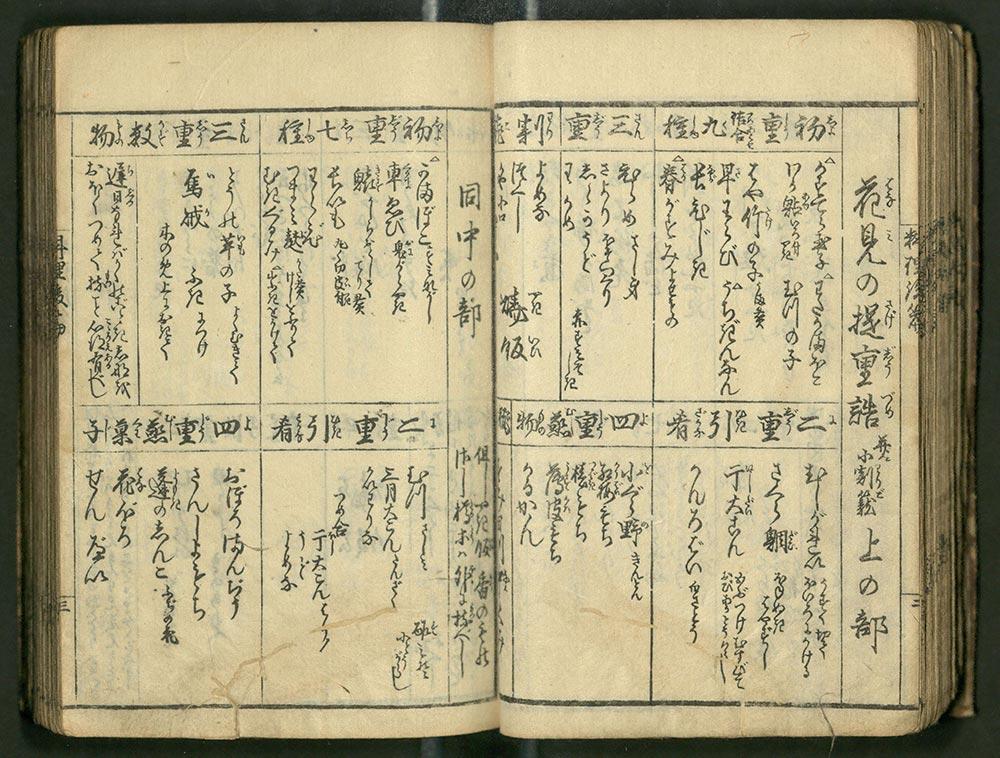
During the Edo period, numerous cookbooks were published. Starting with the publication of The Story of Food in the 20th year of the Kan'ei Era (1643), from the highly practical longtime bestseller The ABC's of Cooking (1773) to the 'One Hundred Rare Recipe' series, such as Tōfu hyakuchin (One Hundred Rare Tofu Recipes, 1782), there were many distinctive cookbooks that remain in existence to this day. In these Edo period cookbooks, I searched for eel recipes, but it seems like there was little cooking at home in those days. Compared to other seafood, these books contain few eel or sardine recipes. Most of the eel recipes are introduced in a section titled 'Eel and Tofu'. At the so-called devotional food section, recipes in which tofu is prepared in a similar way as eel appear, but there are no eel recipes in this book.

In Ryōri chinmi shū (Collection of Rare Recipes, 1764), an eel soup with miso, spring onion and eel can be found, and in Manpō ryōri himitsubako (a Secret Box Filled with a Myriad of Treasured Cooking Recipes, 1785), the method of grilling eel on skewers with soy sauce is recorded. In Ryōri haya shinan (Quick Guidance for Cooking), published in the first year of the Bunka Era (1804), recipes like chawan mushi (egg custard) with grilled eel are first introduced. Only the simple recipe that reads: "peal the egg, put it in the bowl, steam it and add scrambled ginger", appears in this book. While this recipe is extremely simple, it is also an ambitious recipe that combines egg and eel, two ingredients highly valued in Edo. Add egg to leftover eel, wait for a bit, warm it up until the aroma reappears, put the grilled eel in the thick chawan mushi and it's done. By simply adding egg, without adding stock, this is a very natural recipe that is just right for finishing up a meal. The taste for grilled eel continues to this day. No matter how long ago, ukiyo-e and cookbooks convey to us how much the people of Edo already loved the taste of grilled eel.
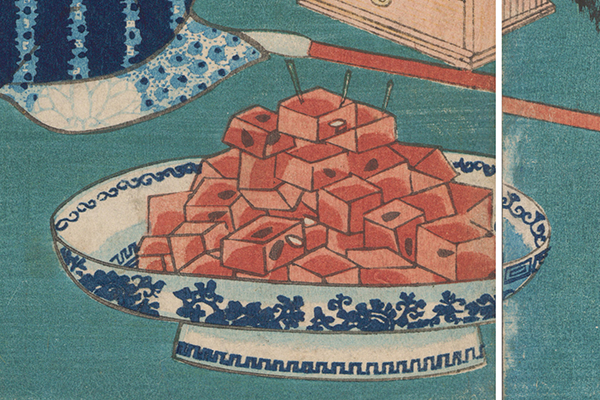
A thick pile of watermelon, with exactly three toothpicks stuck in for three people. The freshness of the fruit is expressed through the deep and bright red color of the pile. The red and white seeds that can often be seen in watermelons reveal Toyokuni's eye for detail.

During Edo summers, peddlers sold rice flour dumplings in cold water while walking through town. According to Morisada's Sketches, a series of publications describing daily life in the Edo period, their price depended on the amount of sugar in the dumplings. It was truly special to eat these rice flour dumplings floating in cold water when it was hot.
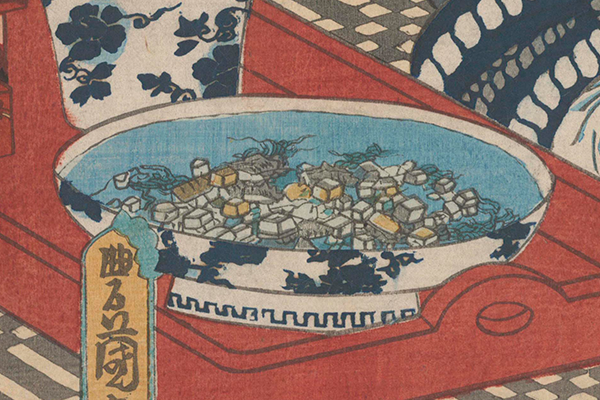
Small fruits floating in the water as small as confetti. These watery snacks that consisted of the sweet taste of fruits and cold water from the wells, made for a perfect water and sugar supply in summer. Like today, they may have also functioned as refreshments and sources of rehydration.
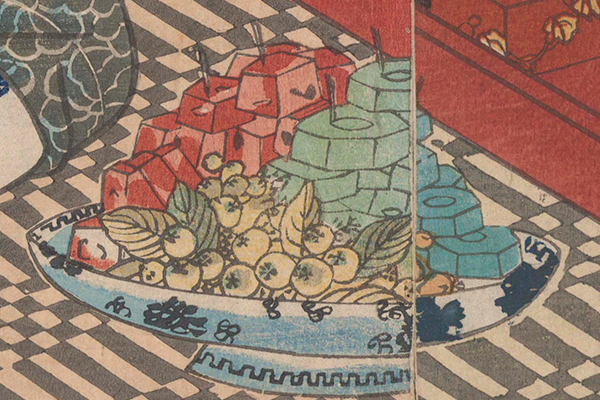
With much reclaimed land in Edo, it was difficult to acquire high quality drinking water. Therefore, the government recommended eating fruits to stay hydrated during summer. As a watery fruit that could be kept long, people especially valued oriental melon.
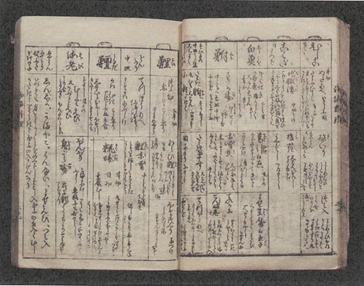
Quick Guidance for Cooking
Written by Daigo Sanjin
The first volume of Quick Guidance for Cooking was published in 1801. After the first and second volume, a third volume was published in 1802, and a fourth volume in 1804. The preface of the first volume introduces dishes of the four seasons with pictures, including their ingredients and recipes. On the left page eel is introduced with the grilled eel in egg custard recipe below.
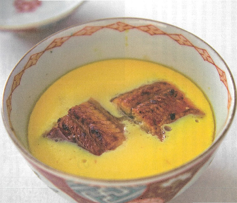 ©Akio Takeuchi
©Akio TakeuchiGrilled Eel in Egg Custard
Ingredients: grilled eel and eggs
1.Cut the grilled eel and put the pieces in a bowl.
2.Break the eggs and pour them over the eel.
3.Steam for 15 minutes.
During the Edo period, eggs with a high value of nutrition were treasured and very expensive. The combination of the eel's aroma with the egg's flavor provide this dish with a rich taste.

